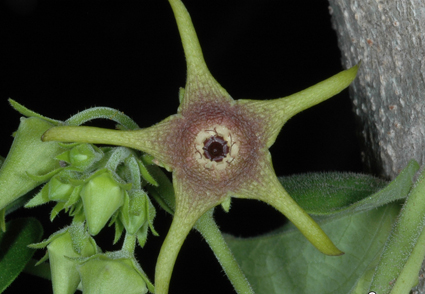Abstract
Polystemma stevensii, a new species from Michoacán, Mexico, is described and illustrated. It grows in tropical deciduous forest in the Balsas Depression at elevations from 350 to 750 m. Polystemma stevensii is similar to P. viridiflorum but differs by having a gynostegial corona with five lobes fused at the base to form a discontinuous flat ring (vs. not forming a discontinuous flat ring), an internal corona with two deltate lobes (vs. with one ligulate lobe), and globose style head (vs. flat style head). A distribution map of the new species and a key to determine the Polystemma species of Michoacán are provided. Following IUCN Red List guidelines, it is assigned a preliminary category of endangered, EN B1ab(i,ii,iii)+2ab(i,ii,iii). Polystemma now includes eight species, of which five are endemic to Mexico.
References
- Abràmoff, M.D., Magalhães, P.J. & Ram, S.J. (2004) Image processing with ImageJ. Biophotonics International 11: 36–42.
- Alvarado-Cárdenas, L.O., Lozada-Pérez, L., Islas-Hernández, C.S., Cortez, E.B., Maya-Mandujano, K.G. & Chávez-Hernández, M.G. (2020) Apocináceas de ayer y hoy. Conocimiento histórico y reevaluación de la diversidad y distribución de Apocynaceae en México. Botanical Sciences 98: 393–416. https://doi.org/10.17129/botsci.2525
- Alvarado-Cárdenas, L.O., Chávez-Hernández, M.G. & Velazco-Macías, C.G. (2021) Ajustes taxonómicos en Apocynaceae Mexicanas. Phytoneuron 47: 1–22.
- Bachman, S., Moat, J., Hill, A.W., de la Torre, J. & Scott, B. (2011) Supporting Red List threat assessments with GeoCAT: geospatial conservation assessment tool. ZooKeys 150: 117–126. https://doi.org/10.3897/zookeys.150.2109
- Brandegee, T.S. (1908) New species of Mexican plants. Zöe 5: 244–262.
- Decaisne, J. (1844) Asclepiadeae. In: De Candolle, A. (Ed.) Prodromus Systematis Naturalis Regni Vegetabilis, vol. 8. Sumptibus sociorum Treuttel et Würtz, Paris, pp. 490–665.
- de Queiroz, K. (2005) A unified concept of species and its consequences for the future of taxonomy. Proceedings of the California Academy of Sciences 56: 196–215.
- Fishbein, M. (2017) Taxonomic adjustments in North American Apocynaceae. Phytologia 99: 86–88.
- Gray, A. (1885) Contributions to the botany of North America. Proceedings of the American Academy of Arts and Sciences, n. s. 12: 257–310. https://doi.org/10.2307/25138773
- Hernández Barón, G.M. (2021) Sistemática del género Polystemma (Gonolobinae, Apocynaceae). Unpublished Master’s Thesis. Universidad de Guadalajara, Centro Universitario de Ciencias Biológicas y Agropecuarias, Guadalajara, 110 pp.
- Instituto Nacional de Estadística, Geografía e Informática (INEGI) (2019) ‘División política estatal 1:250000. 2019’, escala: 1:250000. Edición: 1. Instituto Nacional de Estadística, Geografía e Informática. Aguascalientes, México. Available from: https://geoportal.conabio.gob.mx/#!l=dest2019gw:1@m=mixto (accessed January 2022).
- Instituto Nacional de Estadística, Geografía e Informática (INEGI) (2021) “Continuo de elevaciones mexicano (CEM 3.0)” Instituto Nacional de Estadística Geografía e Informática. Available from: https://www.inegi.org.mx/app/geo2/elevacionesmex/ (accessed January 2022).
- IUCN Standards and Petitions Subcommittee. (2022) Guidelines for using the IUCN Red List Categories and Criteria. Version 15.1. Prepared by the Standards and Petitions Subcommittee. Available from: https://nc.iucnredlist.org/redlist/content/attachment_files/RedListGuidelines.pdf (accessed: August 2023)
- Lozada, L. (2010) Polystemma mirandae (Apocynaceae, Asclepiadoideae), una nueva especie de Meìxico. Novon 20: 429–431. https://doi.org/10.3417/2009004
- McDonnell, A. & Fishbein, M. (2016) Polystemma canisferum (Apocynaceae, Asclepiadoideae): a distinctive new gonoloboid milkweed vine from Sonora, Mexico. Phytotaxa 246: 78–84. https://doi.org/10.11646/phytotaxa.246.1.6
- QGIS, Development Team. (2021) QGIS Geographic Information System. Open Source Geospatial Foundation Project. Available from: http://qgis.org (accessed: January 2022).
- Rzedowski, J. (1978) La vegetación de México. Limusa, Ciudad de México, 505 pp.
- Schlechter, R. (1906) Labidostelma. In: Loesener, L. (Ed.) Plantae selerianae. Bulletin de l’Herbier Boissier 6 (ser. 2): 831–871.
- Steinmann, V.W. & Stevens, W.D. (2022) Polystemma fishbeiniana (Apocynaceae, Asclepiadoideae), a new species from the Balsas Depression of Michoacán, Mexico. Botanical Sciences 100: 759–764. https://doi.org/10.17129/botsci.2997
- Steinmann, V.W. (2021) Flora y vegetación de la Reserva de la Biosfera Zicuirán-Infiernillo, Michoacán, México. Botanical Sciences 99 (6): 661–707. https:/doi.org/10.17129/botsci.2706
- Stevens, W.D. (2001) Asclepiadaceae. In: Stevens, W.D., Ulloa, C., Pool, A. & Montiel, O.M. (Eds.) Flora de Nicaragua. Missouri Botanical Garden Press, St. Louis, pp. 234–270.
- Stevens, W.D. (2005) New and interesting milkweeds (Apocynaceae, Asclepiadoideae). Novon 15: 602–619.
- Stevens, W.D. (2009) Apocynaceae. In: Davidse, G., Sousa, M., Knapp, S. & Chiang, F. (Eds.) Flora Mesoamericana, vol. 4. Missouri Botanical Garden Press, St. Louis, pp. 1–662.
- Thiers, B. (2023 [continuously updated]) New York Botanical Garden’s Virtual Herbarium. Index Herbariorum: A Global Directory of Public Herbaria and Associated Staff. 2022. Available online: http://sweetgum.nybg.org/science/ih/ (accessed: August 2023)


